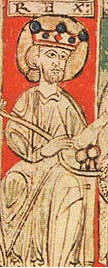<Back to Index>
- Physician Phillippus Aureolus Theophrastus Bombastus von Hohenheim (Paracelsus), 1493
- Painter Frans Snijders, 1579
- King of Castilla Alfonso VIII, 1155
PAGE SPONSOR

Alfonso
VIII (11 November
1155, Soria – 5 October 1214), called the Noble or el de las Navas,
was the King of Castile from 1158 to his death and King of Toledo. He is most remembered for his
part in the Reconquista and the downfall of the Almohad
Caliphate. After having suffered a great defeat with his own
army at Alarcos against the Almohads, he led the coalition of
Christian princes and foreign crusaders who broke the power of the
Almohads in the Battle of the
Navas de Tolosa in
1212, an event which marked the arrival of an irreversible tide of
Christian supremacy on the Iberian
peninsula. His reign saw the domination of Castile over León and, by his alliance with
Aragon, he drew those two spheres of Christian Iberia into close
connection. Alfonso
was born to Sancho III of
Castile and Blanche,
daughter of García
Ramírez of Navarre, in Soria on 11 November 1155. He was named after his
grandfather Alfonso VII of
Castile.
His early life resembled that of other medieval kings. His father died
in 1158 when his mother was also dead. Though proclaimed king when only
three years of age, he was regarded as merely nominal by the unruly
nobles to whom a minority was convenient. Immediately, Castile was
plunged into conflicts between the various noble houses vying for
ascendancy in the inevitable regency. The devotion of a squire of his
household, who carried him on the pommel of his saddle to the
stronghold of San Esteban de
Gormaz, saved him from falling into the hands of the contending
factions. The noble houses of Lara and Castro both claimed the regency,
as did the boy's uncle, Ferdinand II of
León. In 1159 the young Alfonso was put briefly in the
custody of García
Garcés de Aza, who was not wealthy enough to support him.
In March 1160 the Castro and Lara met at the Battle of
Lobregal and the
Castro were victorious, but the guardianship of Alfonso and the regency
fell to Manrique
Pérez de Lara. Alfonso
was put in the custody of the loyal village Ávila.
At barely fifteen, he came forth to do a man's work by restoring his
kingdom to order. It was only by a surprise that he recovered his
capital Toledo from the hands of the Laras. In 1174,
he ceded Uclés to the Order of
Santiago and
afterwards this became the order's principal seat. From Uclés,
he began a campaign which culminated in the reconquest of Cuenca in 1177. The city
surrendered on 21 September, the feast of Saint Matthew,
ever afterwards celebrated by the citizens of the town. Alfonso
took the initiative to ally all the major Christian kingdoms of the
peninsula — Navarre, León, Portugal,
and Aragon — against the Almohads.
By the Treaty of Cazola of 1179, the zones of
expansion of each kingdom were defined. After founding Plasencia (Cáceres)
in 1186, he embarked on a major initiative to unite the Castilian
nobility around the Reconquista. In that year, he recuperated part of La Rioja from the Kingdom of
Navarre. In 1195,
after the treaty with the Almohads was broken, he came to the defence of Alarcos on the river Guadiana,
then the principal Castilian town in the region. At the subsequent Battle of
Alarcos, he was roundly defeated by the caliph Abu Yaqub Yusuf
al-Mansur. The reoccupation of the surrounding territory by the
Almohads was quickly commenced with
Calatrava falling first. For the next
seventeen years, the frontier between Moor and
Castilian was fixed in the hill country just outside Toledo. Finally,
in 1212, through the mediation of Pope Innocent
III, a crusade was called against the Almohads. Castilians under
Alfonso, Aragonese and Catalans under Peter II,
Navarrese under Sancho VII,
and Franks under the archbishop Arnold
of Narbonne all
flocked to the effort. The military orders also lent their support.
Calatrava first, then Alarcos, and finally Benavente were captured before a final
battle was fought at Las Navas de
Tolosa near Santa Elena on 16 July. The caliph Muhammad
an-Nasir was
routed and Almohad power broken. Alfonso
was the founder of the first Spanish university, a studium generale at Palencia,
which, however, did not survive him. His court also served as an
important instrument for Spanish cultural achievement. His marriage (Burgos,
before 17 September 1177) with Eleanor (Leonora),
daughter of Henry II of
England and Eleanor of
Aquitaine,
brought him under the influence of the greatest governing intellect of
his time. Troubadours and sages were always present, largely due to the
influence of Eleanor. Alfonso
died at Gutierre-Muñoz and was succeeded by his
eldest surviving son, Henry I,
named after his maternal grandfather. Alfonso
was the subject for Lion
Feuchtwanger's novel Die Jüdin
von Toledo (The
Jewess of Toledo),
in which is narrated an affair with a Jewish subject in medieval Toledo
in a time when Spain was known to be the land of tolerance and learning
for Jews, Christians, and Muslims. The titular Jewish woman of the
novel is based on Alfonso's historical paramour, Rahel la Fermosa.